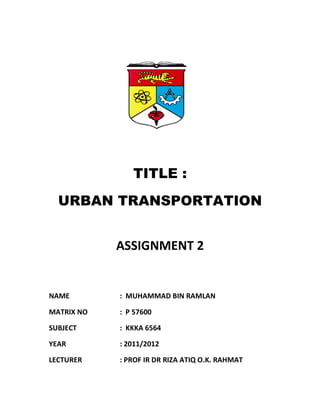KA6564 Assignment 2
- 1. TITLE : URBAN TRANSPORTATION ASSIGNMENT 2 NAME : MUHAMMAD BIN RAMLAN MATRIX NO : P 57600 SUBJECT : KKKA 6564 YEAR : 2011/2012 LECTURER : PROF IR DR RIZA ATIQ O.K. RAHMAT
- 2. QUESTION ASSIGNMENT 2 In an urban transport study, a city is divided into six zones as shown in Figure 1. The summarized land use data is given in Table 1. 5 4 1 2 6 3 Figure 1 Table 1 Zone Residential unit Commercial land use (m2) 1 7,000 6,800,000 2 20,000 370,000 3 31,000 280,000 4 25,000 300,000 5 22,000 360,000 6 35,000 400,000
- 3. Production rate of the residential unit is 1.9 trips per hour and attraction rate of the commercial premises is 3.25 trips per 100 sq. meter floor area. a) Compute the production and attraction of each zone. b) Balance the production and the attraction. c) Compute O-D trip matrix for the city. d) Sketch the trip interchanges
- 4. SOLUTION ASSIGNMENT 2 a) Compute production and attraction of each zone Zone Land Use Production rate Production (Residential Unit) (person-trip / unit / hr) (person-trip / hr) 1 7,000 1.90 7000 x 1.9 = 13,300 2 20,000 1.90 38,000 3 31,000 1.90 58,900 4 25,000 1.90 47,500 5 22,000 1.90 41,800 6 35,000 1.90 66,500 Total 266,000 Zone Land Use Attraction rate Attraction (Commercial (person-trip / m2 / hr) (person-trip / hr) Premises) 1 6,800,000 3.25 6800000 x (3.25/100)= 221,000 2 370,000 3.25 12,025 3 280,000 3.25 9,100 4 300,000 3.25 9,750 5 360,000 3.25 11,700 6 400,000 3.25 13,000 Total 276,575 b) Balance the production and the attraction. Zone Production rate Attraction rate Balanced Production rate Attraction rate 1 13,300 221,000 (13,300/266,000) x (221,000/276,575) 271,288 = 13,564 x 271,288 = 216,775 2 38,000 12,025 38,755 11,795 3 58,900 9,100 60,071 8,926 4 47,500 9,750 48,444 9,564 5 41,800 11,700 42,631 11,476 6 66,500 13,000 67,822 12,751 Total 266,000 276,575 Nil Nil Average (266,000 + 276,575) / 2 = 271,288
- 5. c) Compute O-D trip matrix for the city. Zone 1 2 3 4 5 6 Value 216,775 11,795 8,926 9,564 11,476 12,751 1 13,564 (13,564/271,288) x 590 446 478 574 638 216,775 = 10,838 2 38,755 30,968 1,685 1,275 1,366 1,639 1,822 3 60,071 48,000 2,612 1,976 2,118 2,541 2,823 4 48,444 38,710 2,106 1,594 1,708 2,049 2,277 5 42,631 34,065 1,854 1,403 1,503 1,803 2,004 6 67,822 54,194 2,949 2,232 2,391 2,869 3,188 The O-D trip matrix value for zone 1 until zone 6 is as per bold in the table above.
- 6. d) Sketch the trip interchanges.





